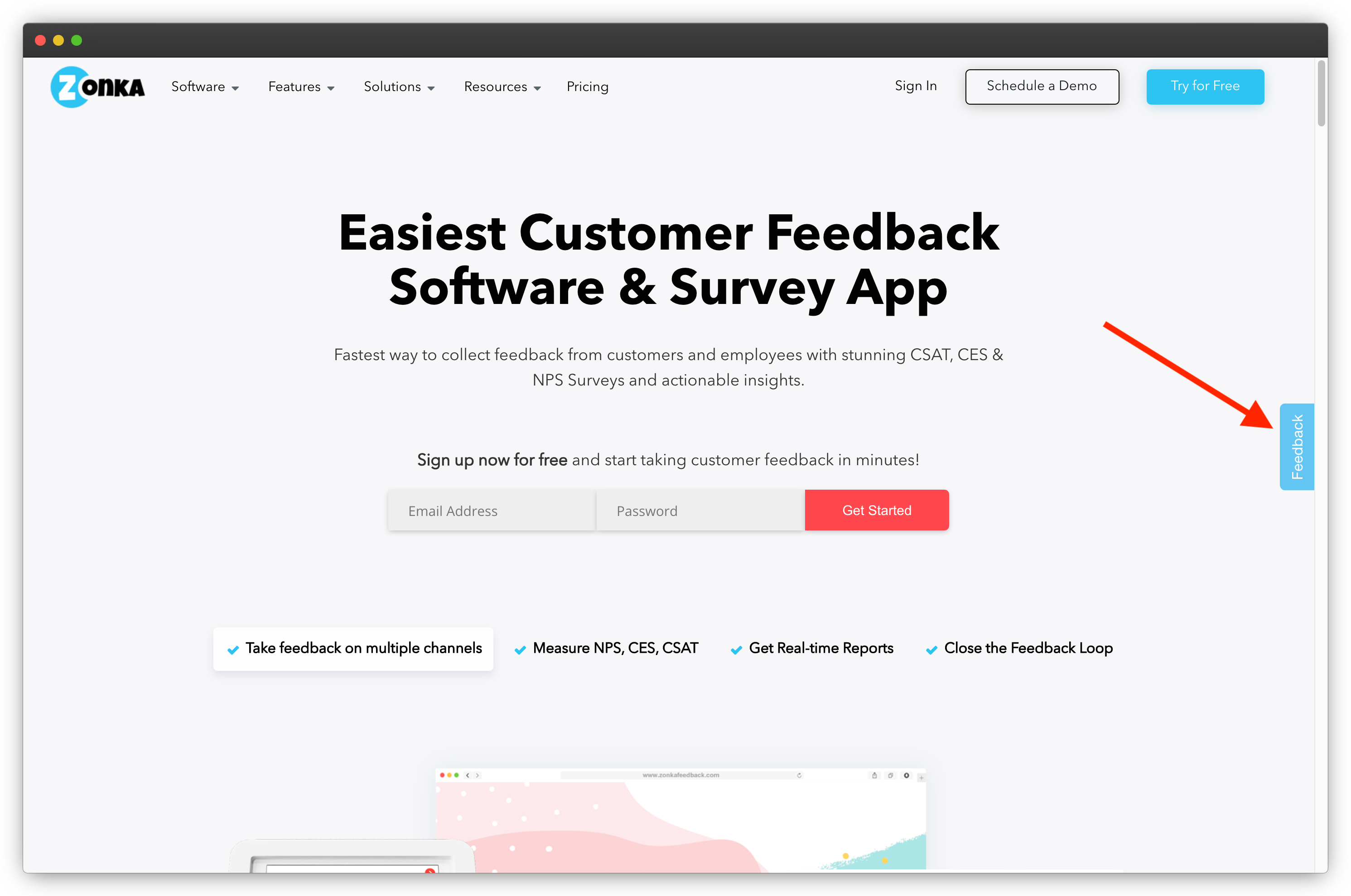You bring visitors to your Website, but what do you do if customers are not staying and not returning? How do you measure whether your visitors are finding what they came looking for or not? And how do you fix it if they don't?
Website Surveys enable you to take direct customer feedback to understand their requirements and optimize your Website performance based on it. Further, they help you improve the overall user experience, enhance your business' conversions, reduce drop-offs, reduce churn and lead to business growth.
Based on the type of Website you run — SaaS, eCommerce, Business, Non-Profit, Educational, Blogs, or more — you can ask the right questions to effectively use Website Surveys to gauge customer needs and customer satisfaction.
In this quick guide, you'll learn about Website Surveys, why they are essential, where on your Website to ask questions, and top Website Survey Questions to ask.
What are Website Surveys?A Website Survey is a way to gather online feedback from website visitors about their experience on the Website, measure their satisfaction, and seek ways to improve.
88% of online consumers are less likely to return to a site after a bad experience. But while they're on the Website, you can fix it by using Website Surveys effectively to know what is working and what is not working on your Website.
You can use Surveys in different ways and forms on your Website — popup surveys, Website feedback buttons, slide-out surveys, Website embed, and more at various touchpoints. For instance, you can measure general Website experience with a feedback button on your Website home page or display a feedback popup survey after a customer has completed a transaction on your Website.
Why are Website Surveys important?
75% of customers admit to making judgments on a company’s credibility based on the company’s Website.
Your Website is likely to be the first interaction point for your potential customers or visitors to seek information about your products, services, or business. It represents your brand image. If the visitors find something unsuitable on your Website that leads to a negative experience, they leave your Website. Subsequently, that puts you at risk of losing the leads, customers, and ultimately money. The only way to avoid this is really to ask customers what they need, and using Website Surveys is the perfect way to listen and understand customers' (potential and existing) requirements.
Here are some compelling reasons why Website Surveys are essential and can be utilized by all types of businesses.
-
To listen to the customers or Website Visitors
We've said this before. Want to hear the Voice of Customer (VoC)? Ask them directly. It's the best way to determine whether your Website fails to meet or surpasses your customer expectations. Moreover, website survey responses help you understand customers' behavior and requirements and lead to operational improvements in your business.
-
To retain customers
Getting customers' feedback equips you with data to help retain customers - you know what's working, what's not working and can take business decisions that help reduce churn. Acquiring new customers costs up to 7x more than retaining an old one. And beyond saving cost, retaining customers leads to profitability, brand trust, and customer loyalty.
The probability of selling to an existing customer is 3x to 35x higher than to a new one. When you are trying to sell a product, you have a 60%-70% chance of making a sale with a returning customer. The probability of the same with a new customer is 5%-20%.
And apart from this, if we look at customers' perspectives - consumers are more comfortable and responsive to those companies with whom they're already familiar. All you need to do is to understand their issues through surveys and take actions to improve their experience and bring them on board again. Thus, nurturing your relationship with your existing customers will help you to enhance customer loyalty. -
To improve word-of-mouth marketing
According to the Ogilvy Cannes study, 74% of consumers identify word-of-mouth as a key influencer in their purchasing decisions. Word-of-mouth marketing is a must for improving the brand image and Website. When your happy visitors give you positive feedback, they'll not stop here only. They'll share their good experience with others and recommend your brand to others as well. This advocates your brand without investing in anything.
Where on your Website should you ask Survey Questions?
While implementing surveys on your website, there are two critical things to focus on one is the placement of your survey, and the second is the question you ask. You can place a survey ideally where it doesn't interrupt the web journey of customers.
The decision of survey placement critically depends on what precisely you are seeking from the survey. If you want to know how visitors find your product page, then placing a survey on the landing page is a great option.
Some of the best places to trigger website surveys may be - pages that are important to your website (customer support, knowledge base, blogs), underperforming pages having a high exit rate, or pages where conversion is significantly less, like cart abandonment (Ecommerce website) and so on.
On Home Page
Home Page is likely to be the first interaction point for your potential customers or visitors to seek information about your products, services, or brand. So, Home Page Surveys are a great way to understand visitors’ first impressions of your website. Whether you represent your survey in the form of a button or a popover, make sure that they don't distract visitors' journey initially.
For example, we have a home page survey in the form of a button at Zonka Feedback.

Survey Question for Home Page
1. Where exactly did you first hear about us?
2. How well do you understand what (COMPANY) does from this home page?
On Landing Pages
According to HubSpot, 38% of people will stop engaging with a website if the content or layout is unattractive. So, it is important to find out that 38% of people listen to them and understand their pain points. Here, Landing Page Survey can help you.
Data captured from lead surveys provide a comprehensive view of the performance of your landing page. You can easily track - what is not working, what is missing, what is distracting audiences from continuing their journey, and so on. Consider triggering a survey 50 seconds after visitors visit the website or scrolled halfway down.
Survey Questions for Landing Pages
3. Did you find the information you were looking for on this page?
4. What's the ONE thing missing from this page?
5. If you could no longer use this website, what is the ONE thing you’d miss most?
On Success Page or Post-Purchase Surveys
If you are looking to capture a quick customer reaction formed on instant desired action like post-purchase, signing up for a newsletter, buying a subscription, then Success Page is an excellent source for you. Triggering surveys at this stage is very fruitful as it provides real-time data based on instant customers' perceptions. You'll understand a few crucial things like the strong points of your website, what makes your customers choose you over your competitors, and so on.
You can send a post-purchase survey as soon as the customer completed the order or transaction. To get feedback in detail, you can send Post Transaction NPS Survey along with a follow-up question to understand and reduce friction (customers' painpoints) during the purchase process.
Survey Question for Success Page or Post-Purchase
6. How likely are you to recommend [us] to a friend or colleague?
7. Rate how strongly you disagree or agree with the following statement: [Website] made it easy for me to [complete the transaction].
8. How satisfied were you with your overall experience on our site today?
9. How easy was it to complete your purchase?
10. What was the main concern or fear you had before purchasing?
11. What was the main thing that persuaded you to purchase?
On Cancellation or Downgrade Pages
Cancellation or downgrade is expected in a SaaS company. Customers are likely to cancel services or downgrade accounts. It is challenging for you to see your customers go away from your website, but you should still try and connect with your customers through a website survey.
Responses of the surveys help you identify the inconveniences and weak points in your services that made customers churn. Based on the answers, you can take desired actions (like upgrading your services, adding new features, working on price, etc.) to improve customer retention rates.
Consider asking for website surveys immediately after users cancel or downgrade their accounts.
Survey Question for Cancellation or Downgrade Pages
12. How would you rate your overall experience with [our company]? Can you tell us a bit more about your rating?
13. Is pricing is the reason for cancellation or downgrade?
14. Follow-up Question - What are the reasons you’ve decided to cancel your account?
15. Follow-up Question - Is there anything we can do to change your mind?
On Pages with High Exit Rates
A high exit rate refers to the situation where many visitors exit or close the website page after a few seconds. There could be many reasons for leaving your website like visitors are not getting what they want from that page. Thus, placing surveys on this page can help you quickly identify the customer churn reasons. Trigger survey on those pages where you want users to complete an action.
Survey Question for Pages with High Exit Rates
16. Were you looking for anything today that you could not find?
17. Was there anything specifically that made you exit from the page?
18. Follow-up Question - What could we have done better?
19. Is there something keeping you from [completing your purchase/signing up for a free trial]?
20. How can we help you?
On Customer Support Page
To ensure better customer support service, you need to embed a survey form on the customer support page. The best way to analyze the performance of your customer support page is by triggering a Customer Effort Score Survey. CES is a customer experience metric survey that provides a pretty straightforward question - how easy or not easy it was for customers to interact with the company and the customer service and support teams.
Based on the responses to the CES Survey and Follow-up questions, you can evaluate essential things like ease of doing business with you, user-friendliness of content on the customer support page, ease of accessing information, comfort, effectiveness, and helpfulness of your customer support agents, ease of getting queries resolved, and so on. Focusing and improving all these things can help you cut down the number of help desk tickets and speed up the conversion process.
Consider triggering CES Survey at the help desk page.
Survey Question for Customer Support Page
21. Did you find what you were looking for?
22. Was the content on this page helpful?
23. How satisfied were you with the content on this page?
24. Rate how strongly you disagree or agree with the following statement: [Help Article] made it easy for me to [solve my issue].
Set up Website Surveys with Zonka Feedback
Zonka Feedback facilitates you to create professional and engaging website surveys. Not only this, but you can also decide on the appearance and placement of your feedback form in particular conditions. We can do this efficiently through on-page surveys, popover surveys, and so on. After obtaining all the responses, you can combine all the data and view the analytics.
You can represent your website feedback form in two ways:
Embed Type
In this, you can embed the created survey on your website. You can access the feedback's source code and add the feedback form inline on your web page or blog. Backed by the robust functionality, Zonka Feedback facilitates an option to configure your feedback based on your website/app. You can change the height and width of your survey. Customize the look of your survey to match your website or app.
Widget Type
Add the feedback form as a popover or a button on your website. Zonka Feedback enables you to configure how and when your survey widget should appear on your website or blog. You can do this through appearance, visitor targeting, and behavior settings.
Setting Appearance of your Widget (Popups and Button)
Zonka Feedback enables you to have an Appearance setting in the following ways:
- Popup Surveys - Zonka Feedback facilitates you to customize your popup survey appearance. You can either place your survey popup in the center of the screen or slide it at the bottom. Popup survey ensures that your visitors respond to the survey and then move to the following action.
- Button Surveys - In this widget type, you can choose to place your button at the edge of either the right or left side of a web page. Besides these, you can also set a free button anywhere on the website.
Setting Targeting of your Website Survey
Usually, you have a different group of customers as per different customer stages. In this scenario, sending other surveys to different target groups requires lots of effort. So, to make your task easy, Zonka Feedback enables you to configure your Target surveys as per different conditions easily.
- User Setting - This setting facilitates you to set the Widget's visibility based on the number of users, including - All users, Percentage of users, and users based on specific attributes (Country, Gender, Timezone, and so on.)
- Device Setting - This helps you to customize the visibility of your Widget on devices. With Zonka Feedback, you can select the devices, including Desktop, Tablet, or Mobile, where you want to make your popover/Button appear. This setting will ensure that your Web Widget is displayed so that it matches your devices.
- Page Setting - This setting helps you to customize the visibility of your widget. You can either show your widget on all pages or any specific page like Exit Survey at Exit page.
Setting Your Widget's Behavior
Behavior refers to how your survey needs to behave post-launch of the Widget on your website. You can set when your visitors should see your Feedback Widget and till when it is visible. Zonka Feedback provides you with the three options to choose from:
-
Immediately when the page loads
-
After a delay of 'y' seconds
-
When the user scrolls 'y' percentage down the page
You can also set the criteria till when visitors can see the Feedback Widget. In short, it allows you to decide if you want to show it once or more than once. For example, you can set the appearance of the feedback widget until customers submit a response, only once, even if they did not receive a response, or Over and over, even if they submit a response.
Tips for creating a good Website Survey
For creating a good website feedback form, you don't have to be an expert or need any technical know-how. Even a novice can create, distribute, and analyze website feedback by following some tips and tricks. Here are some best tips that help you to build the best surveys possible.
-
Create a short and attractive survey that is more accurate
Keep your survey short and straightforward. Try to avoid complex questions that mislead your audience; otherwise, they give the wrong answer or leave your survey. You can also add survey logic to improve the survey experience of your web visitors.
-
Optimize your surveys for different devices
In 2021, the number of smartphone users in the world today is 3.8 Billion. Thus, the probability of expanding the reach of the survey is high with mobile users. It would be best to optimize your website surveys for different devices, including Mobile, iPad, and Android Tablets. Responsive surveys help your customers to attend surveys on any device.
-
Provide an open-ended question so respondents can share open comments
An open-ended question refers to a follow-up question that allows your customers to elaborate on their issues and express their opinions through sentences, records, and stories. You can choose different types of survey questions while designing your feedback form.
-
Decrease the frequency of your surveys. Appearance too many times may annoy your visitors
Sending surveys frequently to customers may lead to survey fatigue. As a result, customers will either leave or spam your surveys. To avoid this, you can trigger the schedule of the survey through API Integrations available in the Website Survey Software.
-
Test your survey
It is better to test your survey before sending it live on the website. Send your surveys to your colleagues and tell them to spot as many errors as they can. Survey Test helps you to identify the issues and fix them quickly to improve surveys before they go live.
 Integrations
Integrations




.png)

 (1).jpg)
.jpg)

.jpg)


.jpg)

















